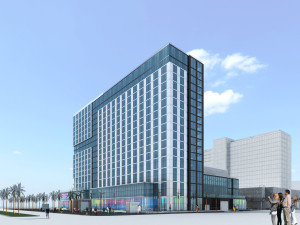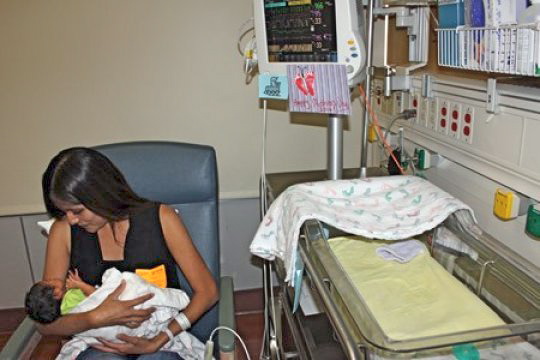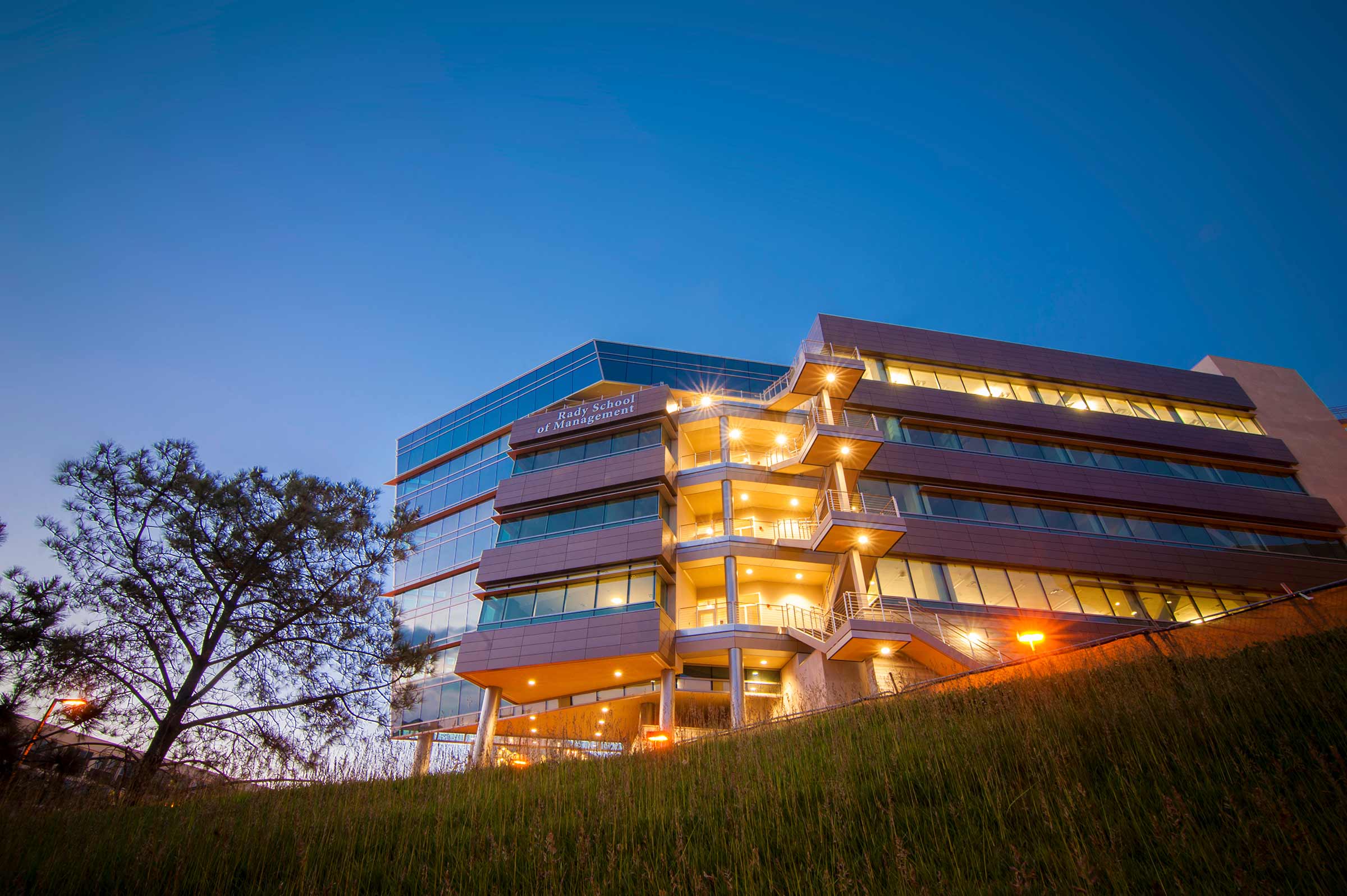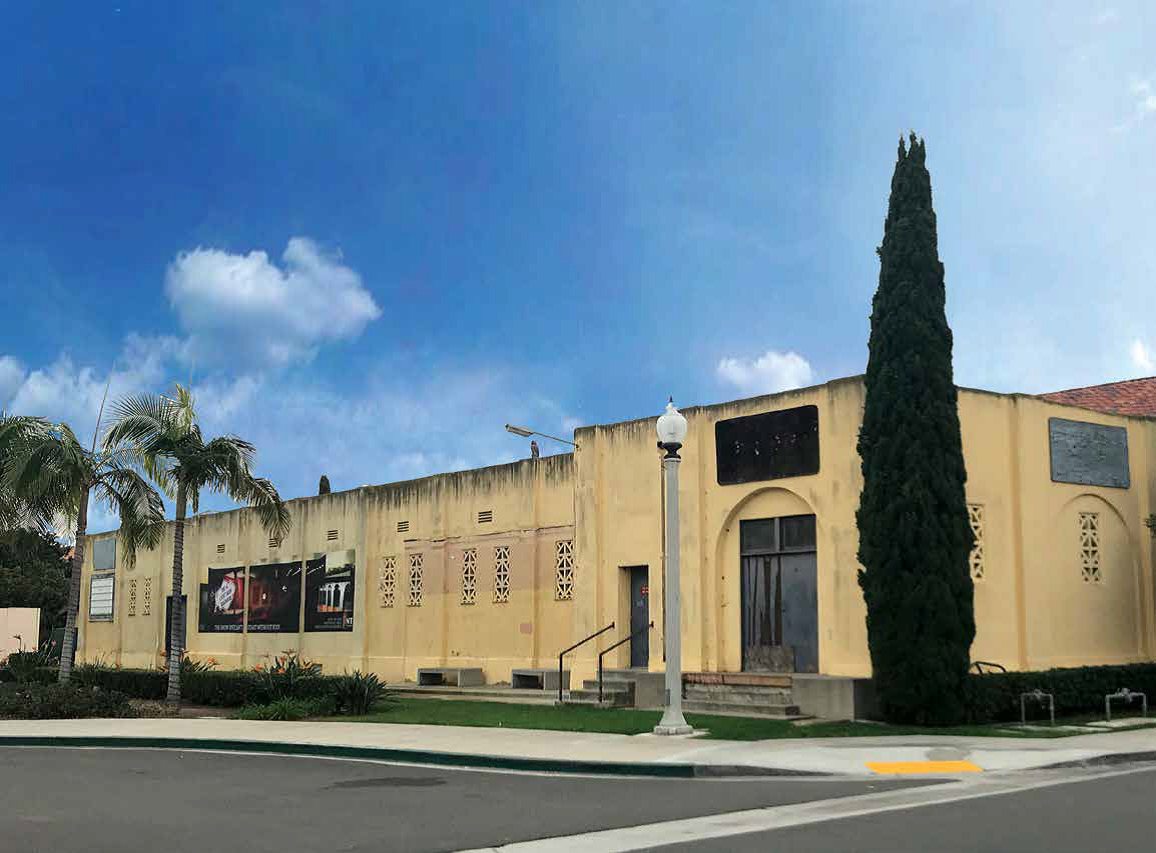Daily Business Report-May 11, 2016
Rendering of the InterContinental Hotels property. (Courtesy of Lankford-Phelps-Portman)
Construction Starts on 18-Story
InterContinental Hotel Downtown
Construction began Tuesday on the second phase of BRIC, the InterContinental Hotels & Resorts property that will feature 400 guest rooms above ground-level restaurants and shops along Broadway and Pacific Highway in Downtown San Diego.

The property is the former site of Lane Field.
Hong Kong-based China Orient Asset Management International provided equity financing and PNC Bank N.A. & Regions Bank provided construction loans for the $217 million development.
“Beginning construction of this second phase of BRIC’s development is a major milestone for a significant addition to San Diego’s North Embarcadero area,” said Ambrish Baisiwala, CEO of Portman Holdings. “We have been working with our partners at Lankford & Associates and Hensel Phelps for many years to bring this entire mixed-use development to fruition, and are thrilled to break ground on this new phase, bringing the first full service luxury property to San Diego’s waterfront in quite some time.”
The development team consists of Portman Holdings, Lankford & Associates and Hensel Phelps.
The joint venture also developed BRIC’s first phase together, the adjacent SpringHill Suites and Residence Inn, which opened earlier this year.
Plans for the 18-story hotel include a signature restaurant and bar located on level three, with expansive views of the San Diego Bay. It is part of several multi-level indoor/outdoor terraces and balconies that offer similar views. The hotel will have 23,000 square feet of ballrooms and meeting space. The two ballrooms each have a full glass wall with views of Downtown and the bay. Also included is an outdoor pool, fitness center, spa and rooftop bar. The development, along with its 32,850 square feet of ground- level restaurants and shops along Broadway and Pacific Highway, will include a landscaped walkway and plaza along Broadway, and 686 parking spaces in a subterranean garage, 271 of which are available to the public.
John Portman & Associates designing the building, and general contractor Helsel Phelps plans to complete construction in September 2018.
_____________________________________________

Iconic Hotel Churchill Sign Lifted
Back to the Rooftop After its Restoration
Restored to its original 1940s condition, a sign that graced the top of the Hotel Churchill in Downtown San Diego for more than 70 years was lifted back into place on Tuesday, made ready for this summer’s grand reopening of the century-old hotel.

A five-person crew used a crane to begin to hoist the six panels that form the 32-foot-wide and 10-foot-tall sign one at a time. By 11:30 a.m., the sign, with hand-painted letters that are nearly 4 feet tall each, was back up on the rooftop of the seven-story Hotel Churchill. The almost 2,000 pound sign had been removed from the rooftop on June 30, 2015, for restoration.
The sign was restored to its original condition, handiwork that took about 180 hours to complete by San Diego Electric Sign, a subcontractor working with Allgire General Contractors, the general contractor of the rehabilitation of Hotel Churchill.
The San Diego Housing Commission, working with its nonprofit affiliate, Housing Development Partners, is rehabilitating the historical Hotel Churchill to create 72 permanent affordable housing studios with supportive services for homeless individuals, including 56 veterans. The studios will remain affordable for 65 years,
The $20.5 million renovation of Hotel Churchill is one of the original five components of the housing commission’s three-year homelessness action plan.
The U.S. Department of Veterans Affairs will provide supportive services for 56 housing units for homeless veterans. In addition, $1.8 million from the State Mental Health Services Act administered by the County of San Diego Mental Health Department, will provide permanent supportive services for the 16 non-veteran adults — eight units for youth aging out of foster care and eight units for adults exiting the corrections system who also need supportive services.

New Technology is Life-Saving
Voice for Premature Infants
A new technology in the Neonatal Intensive Care Unit at UC San Diego Health is able to predict the risk of life-threatening infections up to 24 hours before they appear in severely premature or critically ill infants, according to the health facility. Infection is the leading cause of death in this fragile patient population.
The Heart Rate Observation system, or HeRO, is an innovative monitoring technology that uses an algorithm to detect slight changes in a baby’s heartbeat that could be an early sign of a major infection, like sepsis — a bacterial infection that is highly dangerous to babies born three pounds or less.
“The challenge with diagnosing sepsis is a lot of symptoms for the early stages of the infection are subtle and nonspecific,” said Erika Fernandez, MD, director of the NICU at UC San Diego Health. “With the HeRO technology, we can detect symptoms of sepsis up to 24 hours before the infection actually happens. This allows us to begin an investigation and intervene with treatment before a baby becomes critically ill.”
UC San Diego Health is the first health care provider in San Diego County to use the technology, which can detect infections in the blood stream and intestines. Historically, physicians and nurses have relied upon their own observations to detect signs of infection. The new system reports vital sign trends much earlier than the human eye or traditional equipment and requires no additional wiring to the baby.
“This state-of-the-art technology lets babies be babies, and mothers can breastfeed without worrying about tangling up or unplugging wires,” said Lawrence Prince, MD, chief in the Division of Neonatology at UC San Diego Health. “It makes for a much less intimidating experience for families and a highly improved monitoring approach for medical staff.
The HeRO system uses a zero-to-seven surveillance score generated after a heart rate is analyzed, with anything higher than a two considered an alert for possible infection. Prince says the technology is expected to reduce mortality rates in the NICU by 20 percent.
“Physicians and nurses can evaluate a situation much more thoroughly,” said Prince. “When I look at the data on the monitor, I can ask myself, ‘is there something more going on with the patient and do we need to do further testing?’”
Fernandez added that the monitoring system represents part of the next generation of technology to save lives and help achieve the ultimate goal in the NICU: “To provide the highest quality of comprehensive and compassionate care to NICU babies so they can thrive and go home with their families as soon as possible.”
Illumina Registers Clinical
Products for Use in South Korea
GenomeWeb
Illumina has received a product approval certificate for clinical use for its MiSeqDx instrument and MiSeqDx Universal kit from South Korea’s Ministry of Food and Drug Safety.
The registration allows Illumina to sell its instrument to clinical laboratories in South Korea, and will “accelerate the process for us to get other Illumina clinical products into this market in the future,” Jason Kang, Illumina’s commercial leader in South Korea, said in a statement.
Tim Orpin, Illumina’s vice president and general manager, added that the registration is “an exciting milestone,” and the first step of the company’s regulatory strategy in the Asia Pacific region.
Illumina received premarket clearance from US Food and Drug Administration for the MiSeqDx in November 2013 and a medical device license for the instrument from Health Canada in 2015. MiSeqDx also has CE marking in Europe.
Illumina also received premarket clearance for a version of its NextSeq 500 instrument from the China Food and Drug Administration in conjunction with Berry Genomics’ noninvasive prenatal test.
Local Health Clinics Awarded
$5.6 Million to Improve Services
Health Center Partners, a consortium of primary care organizations, announced that six of its member health centers have received more than $5.6 million from the Department of Health and Human Services to build and renovate their health facilities.
The grants are part of more than $260 million that were awarded to 290 health centers across the country in order to increase capacity and provide additional primary and preventative health services to underserved communities.
“One in six San Diegans relies on community health centers for primary health care,” said Henry Tuttle, CEO of Health Center Partners. “These centers have provided crucial care to those most vulnerable in our community for decades, and we congratulate our members for bringing millions of additional dollars in federal funding to the region in order to reach even more people and meet the growing demand for primary care.”
Centers receiving grants:
• Clinicas de Salud del Pueblo Inc. received $1 million
• North County Health Services received $1 million
• Community Health Systems Inc. received $1 million
• Neighborhood Healthcare received $1 million
• San Ysidro Health Center received $1 million
• Vista Community Clinic received $686,521
USNS Mercy Leaving San Diego
On Humanitarian Mission
By City News Service
The hospital ship USNS Mercy was scheduled to leave San Diego today for the 11th annual Pacific Partnership humanitarian voyage.
The Mercy and its crew of medical and dental professionals, veterinarians, engineers and members of aid organizations will visit Timor Leste, the Philippines, Vietnam, Malaysia, Palau and Indonesia during the 4 1/2-month mission. Personnel from Australia, New Zealand, Japan, Canada and the United Kingdom will also participate.
The Coronado-based Helicopter Sea Combat Squadron 21 will accompany the Mercy.
The deployment will be led by Capt. Tom Williams, commander of the San Diego-based Destroyer Squadron 23.
Pacific Partnership started after the destructive Indian Ocean tsunami in 2004. Participants conduct humanitarian assistance activities and help the visited nations improve maritime security and strengthen disaster response preparedness.
Edison to ‘Participate Fully’
In Reopening San Onofre Settlement
By City News Service
Southern California Edison announced Tuesday that it will “participate fully” in a process set up by the California Public Utilities Commission to reconsider a settlement that apportioned financial responsibilities for the shutdown of the San Onofre Nuclear Generating Station in northern San Diego County.
The CPUC reopened the settlement Monday and established filing dates for parties to comment.
The settlement was reached two years ago between the utilities that own the nuclear plant and ratepayer advocates, but it was criticized when it was learned that conversations between then-CPUC Commissioner Michael Peevey and executives of Edison, the facility’s operator and majority owner, went undisclosed.
The CPUC fined Edison $16.7 million late last year despite denials by the Rosemead-based utility that violations occurred.
The two ratepayer groups that had signed onto the deal, The Utility Reform Network and Office of Ratepayer Advocates, a state agency — both called for the deal to be overturned last summer.




